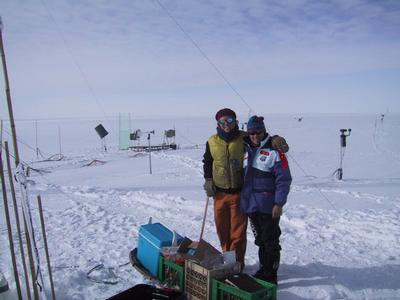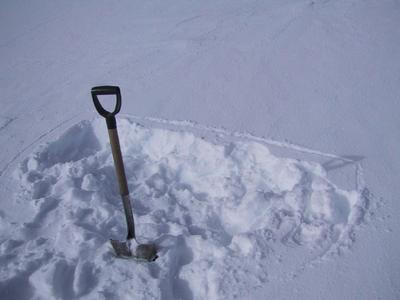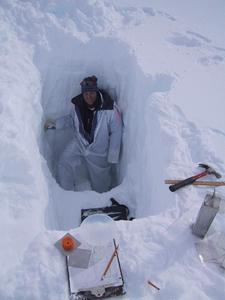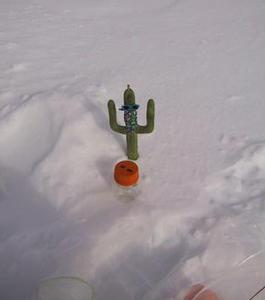25 July, 2001
I didn't think I was doing an archeology project.
We awoke to a perfect day for pit digging. Light winds, not to cold (
1.3 F) and somewhat sunny. Around 9:30 this morning, Meg and I headed out
to dig the monthly one meter snow pit. To save a little effort, we
combined it with the annual two meter pit, that I would dig for the
University of Arizona team. Yesterday, we had prepared our 110 sample
bottles. Meg washed them in the clean room and dried them in the hood. I
weighed each one and packed them in the crate. Today, we would dig a one
meter deep pit and sample snow every centimeter for the first ten
centimeters and then every two centimeters the rest of the way down to
two meters. I volunteered to dig the pit so that Meg could do her other
daily routines in the science trench and clean air zones.
Meg set me up in a good place, not too far away from the science trench,
but not too close either. Happily, I set off to dig. It was fun to dig
the first meter. I worked through it quite quickly. As I began to work
down to the second meter I hit a rope. Archaeology!! I had found a lost
civilization. Since, I knew that this rope was probably from earlier
years of science in this area, I decided to go find Meg before digging
any further. However to my amusement, I realized that my next challenge
was getting out of the hole. I laughed out loud as I realized I had
merrily dug myself into a pit a little too deep to get out of easily. I
remedied the situation by carving a lovely set of steps and crawled back
out to find Meg.
As I stepped into the science trench I said with a laugh, “ I found an
Ancient Civilization!”, and thought not much of it. Meg and I went on
and did our sampling, carefully cutting down into the snow with the
special snow excavator. By lunch I had fifty of the hundred and ten
samples I would need to finish the project. At lunch, I mentioned to Jack
Dibb and Markus that I had found a rope. Jack, who’s been here every
year for 14 years, replied, “ Oh, yea that was a path we had back in
‘97”.
Markus overhearing this, looked at me. Without a word, I knew immediately
--- I going to be digging a second pit. The first pit would have
compacted snow under the old path and would not give us accurate
measurements. Oh well, at least it was a nice day for digging. I headed
off for my second pit, another fifty bottles on my sled. We will use the
data from the first pit as a comparison to the second pit. Something we
call spacial resolution or comparing the data in two different areas. Meg
and Shelly also used the first pit to collect some other data. They
looked at the snow’s stratigraphy or layering for Mary Albert of CRREL.
They also collected some other snow samples for Jack Dibb’s ion
concentration research. I found it interesting that even my breathing in
the pit could alter the gas concentrations for Jack’s research. Jack made
sure that Shelly and Meg cut back away from the original walls of the pit
to gather uncontaminated snow.
The pits should contain snow that has changed over time. The snow in the
pits has been there between one day and five years. When we melt the snow
tomorrow we will look for a change in the gas concentrations with depth.
In the past scientists have found that the concentrations of Formaldehyde
(HCHO) peak at about one half meter of depth in these pits. The deeper
the snow the older it is and the more isolated from the current
atmosphere. I hope that the data is interesting and proves our
hypothesis. But, in any case, it was interesting just being in a pit over
my head.

Meg and I head out to the snow to dig the pit.

Here is the starting line for the pit. I will try not to disturb the snow beyond this line.

Here is the first 20 centimeter core.

In between each core I measured with the meter stick. Its important to keep track of the depths of the samples.

I am standing at the bottom of the 2 meter pit. I have on a tyvek clean suit.

I found I could hang my tools and clipboard from the walls of the pit. It was quite warm down there, out of the wind, I almost had my own office!!

Cactus man, my lab assistant, kept track of the bottles for me.
Contact the TEA in the field at
.
If you cannot connect through your browser, copy the
TEA's e-mail address in the "To:" line of
your favorite e-mail package.
|
